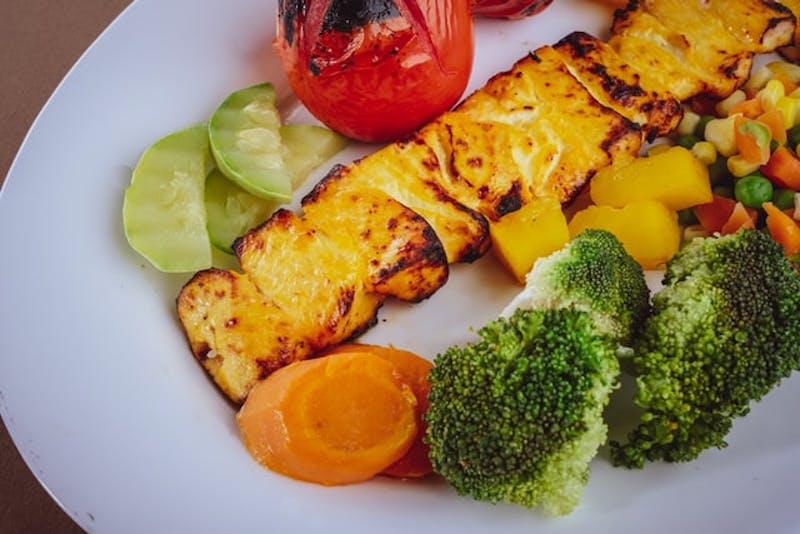
If you’ve been wondering if the Paleo diet is worth a try, here are some of the benefits of the Pale diet—and whether or not it actually works for weight loss.
The Paleo diet—sometimes called the Caveman Diet—is all about eating in the way our ancestors did.
The diet has been around since the 1970s. But it didn’t become mainstream popular until the early 2000s when Loren Cordain published The Paleo Diet: Lose Weight and Get Healthy by Eating the Foods You Were Designed to Eat.
The whole purpose of the diet is to eat what our early hunter-gatherer ancestors presumably ate. “Presumably” because we can never know with 100% certainty what they ate most of across the board, how much of their diet was intentional, and how much was due to environmental circumstances and location.
But the diet has maintained its popularity for decades now. So you may be wondering…how healthy is the diet and can it help you lose weight?
Let’s break down what the research says about the Paleo diet so you can decide if this could be the right diet for you.
What can you eat on the paleo diet?
So what do advocates of the Paleo diet say our prehistoric ancestors ate?
If you want to follow the Paleo diet, then you can count out any processed food to start. That means no potatoes, grains, dairy, and most other desserts.
On the paleo diet, you eat primarily unprocessed meats, fish, eggs, nuts, fruits, and vegetables.
Benefits of the Paleo diet
A systemic review from 2019 found that there is a clear connection between the Paleo diet and weight loss.
One reason it helps with weight loss is that the diet is made up only of filling unprocessed foods. It’s high in protein and low in carbohydrates, and protein is more filling than carbs.
When the foods you eat are more nutrient-dense and filling, this can help curb cravings for other foods later in the day.
This ultimately makes it easier for you to eat fewer calories every day.
Especially when most people’s extra calories come from the snacks and extras we eat. Like when we have a sweet tooth craving. Or the desire to eat half a “family-sized” bag of chips in one sitting (we’ve all been there!).
But the benefits can go beyond weight loss when the diet is done correctly and all nutritional needs are still being met.
Here are three other benefits of the Paleo diet that have been reported in studies:
Improved Glucose Tolerance
One study tracked the differences in weight loss between those on a Paleo diet and the Mediterranean diet.
While participants following both diets had significant and similar weight loss results, there was a difference in their glucose tolerance.
A glucose tolerance test measures how effectively your body clears glucose from your blood. If it doesn’t happen efficiently, then it can be a sign of diabetes and insulin resistance.
By the end of the study, researchers discovered that only the participants on the Paleo diet experienced a notable improvement in glucose tolerance. They even found that at the end of the 12-week study, everyone from the Paleo group had normal blood sugar levels, but only around half from the Mediterranean diet did by the end.
Improvements in cardiovascular risk factors and other metabolic factors
In another comparative study, the Paleo diet was compared to a standard diabetes diet.
A diabetes diet is typically one developed with your doctor or dietician that involves eating whole foods at specific times during the day. The timing is to help moderate the production and usage of insulin.
The results showed greater weight loss and an improvement in other factors by the end of the study for those on the Paleo diet instead of the diabetes diet.
After three months on the diet, those on the Paleo diet lost more weight and saw their triglycerides drop more significantly. Triglycerides are a type of fat found in the blood that your body uses for energy.
Paleo participants also had an increase in HDL cholesterol. HDL is the good cholesterol (LDL is the type you want to avoid).
Another study noted similar results when one group followed the Paleo diet for just ten days. Those participants experienced a decrease in their LDL cholesterol, triglycerides, and blood pressure.
Possible concerns with the Paleo diet
According to the Mayo Clinic, one of the primary concerns with the Paleo diet is the absence of certain food groups.
While cutting out highly processed fats and sugars does have health benefits, the diet leaves out whole grains and legumes. Both types of foods are high in fiber, vitamins, and other micronutrients that make positive contributions to your overall health.
There are also some concerns about the claim that our ancestors didn’t eat grains. Some archaeologists have found evidence that humans ate grains as far back as 30,000 years ago.
And there’s some genetic evidence that our biology changed to easily digest grains and other foods the Paleo diet cuts out. Meaning it’s a nonissue for your digestive health unless there is another underlying condition at play (which is certainly possible if you have a difficult time with gluten).
There’s also no way to prove that our ancestors’ diet was healthier than the standard whole-foods-based nutritious diet. It’s difficult to know and prove what diseases or health complications early humans had or didn’t have as a result of their diet.
And finally, the Paleo diet is also more restrictive than other diets. Restrictive diets can be harder to follow in the long run unless you find the diet enjoyable and easy to stick to.
Is Paleo right for you?
Whether Paleo is right for you will depend on many factors—your health concerns, your preferred mode of dieting, and your lifestyle.
The diet has proven beneficial for some who want to lose weight and improve their cardiovascular risk factors.
Fortunately, deciding whether or not the Paleo diet is right for you isn’t something you have to guess at or figure out alone.
At Valley Medical Weight Loss, we work with each of our weight loss patients to figure out what the right weight loss plan is for you. We factor in everything about your health, your individual needs, and your long-term goals.
There are so many ways to tackle your weight loss journey, and we’re here to help you get through the overwhelm of figuring it out alone.
When you’re ready for support and a real plan that’ll get results, reach out to your closest Valley Medical Weight Loss location.
Our experts are ready to help you achieve your weight loss goals.
Sources
- Challa, Hima J. “Paleolithic Diet.” StatPearls [Internet]., U.S. National Library of Medicine, 10 July 2020, https://www.ncbi.nlm.nih.gov/books/NBK482457/.
- de Menezes, Ehrika Vanessa Almeida, et al. “Influence of Paleolithic Diet on Anthropometric Markers in Chronic Diseases: Systematic Review and Meta-Analysis.” Nutrition Journal, BioMed Central, 23 July 2019, www.ncbi.nlm.nih.gov/pmc/articles/PMC6647066/.
- C. Nielson, T. Lange, et al. “A Palaeolithic Diet Improves Glucose Tolerance More than a Mediterranean-like Diet in Individuals with Ischaemic Heart Disease.” Diabetologia, Springer-Verlag, 1 Jan. 1970, link.springer.com/article/10.1007/s00125-007-0716-y.
- Jönsson, Tommy, et al. “Beneficial Effects of a Paleolithic Diet on Cardiovascular Risk Factors in Type 2 Diabetes: a Randomized Cross-over Pilot Study.” Cardiovascular Diabetology, BioMed Central, 16 July 2009, www.ncbi.nlm.nih.gov/pmc/articles/PMC2724493/.
- Frassetto, L A, et al. “Metabolic and Physiologic Improvements from Consuming a Paleolithic, Hunter-Gatherer Type Diet.” Nature News, Nature Publishing Group, 11 Feb. 2009, www.nature.com/articles/ejcn20094.
- “Paleo Diet: Eat like a Cave Man and Lose Weight?” Mayo Clinic, Mayo Foundation for Medical Education and Research, 25 Aug. 2020, www.mayoclinic.org/healthy-lifestyle/nutrition-and-healthy-eating/in-depth/paleo-diet/art-20111182.

